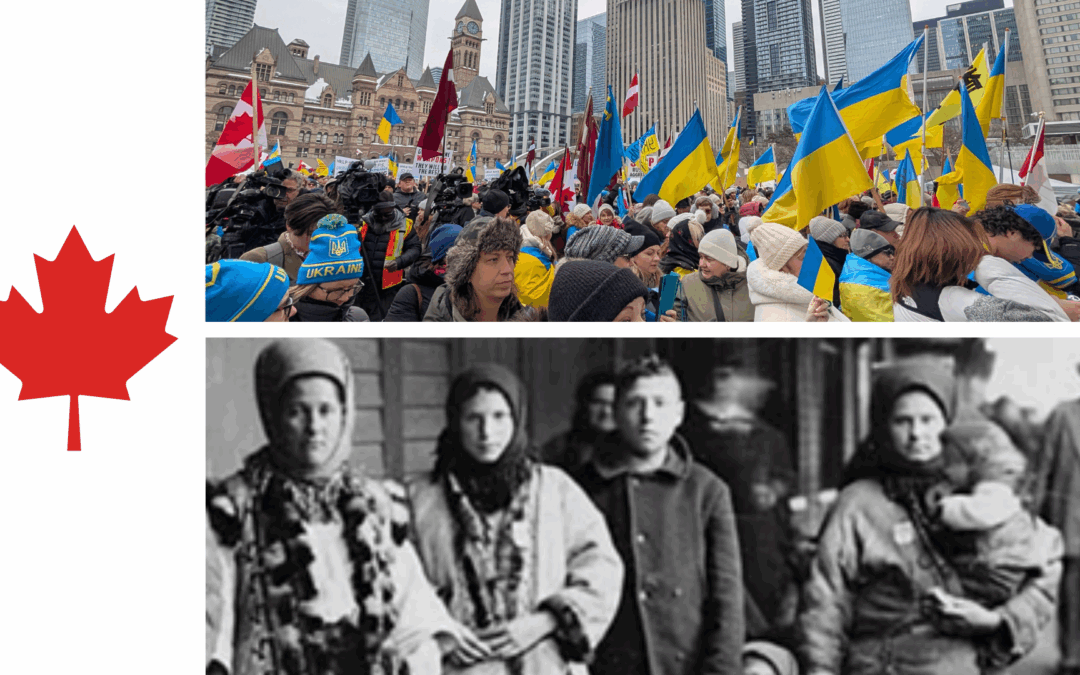Written by SUSK Canada Summer Job Intern – Daniil Zhelezniak (Saint Mary’s University)
International Youth Day
Today, we join communities across Canada and around the world in marking International Youth Day — a time to recognize the vision, talent, and dedication of young people. Over the past 100 years, Canada has become a new and safe home for thousands of young immigrants, including those from Ukraine. However, this immigration was different, had different causes, and changed rapidly with each passing decade.
After the end of World War I, a Ukrainian teenager from the former Austria-Hungary, who had recently arrived in Canada, may have helped his family grow crops in the Prairie provinces. A century later, an immigrant from independent and democratic Ukraine attends a multicultural high school in Toronto, checking the news from war-torn Ukraine on his phone.
Even though both generations of Ukrainian youth were separated by time and circumstances, they share the experience of adaptation, upheaval, and resilience. This Youth Day article briefly compares the paths of those who immigrated during the interwar period (1920s–1930s) and those who arrived after 2022 under the Canadian‐Ukrainian Emergency Travel Authorization Program (CUAET). It explores how identity, hardship, community building, and cultural preservation influenced these two waves of migration — from early 20th-century farms to modern Canadian cities — and how support systems and integration experiences evolved over time.

Prairie Beginnings: Ukrainian Youth in the 1920s–30s
The interwar period was marked by changes in immigration legislation and the second wave of Ukrainian immigration to Canada, during which approximately 68,000 Ukrainians arrived in the country between 1919 and 1939, especially from Galicia, Volyn, Bukovyna, and Bessarabia (Makuch & Swyripa, 2008). These immigrants were heavily influenced by severe economic problems, repressions, World War I, the collapse of empires, as well as Ukraine’s struggle for independence during the Russian Civil War, and they created patriotic organizations in their new homeland (Zaiets & Loehrke, 2025). Canada, in need of settlers and labor, opened its doors to young Eastern Europeans, famed for their agricultural expertise and strong work ethic. Unlike the pioneer generation before World War I, who often immigrated as whole families, in the 1920s, mostly single men emigrated, although a significant number of young unmarried women worked as domestic servants or in agriculture.
The Prairies were the main focus of this wave of immigration for Ukrainians. The Canadian government offered Ukrainians 160 acres of land in the western plains for a fee of $10, enticing them with promises of fertile land (McCracken, 2015). By the 1920s, large Ukrainian farms were already scattered across the cold steppes of Manitoba, Saskatchewan and Alberta, where fellow Ukrainians could help each other settle. By 1931, more than 85% of all Canadian Ukrainians lived in the three provinces of the Prairies, and more than three quarters of them were employed in agriculture, since the employment options were limited (Makuch & Swyripa, 2008). These young immigrants and their Canadian-born children faced the harsh climate of western Canada – long winters, isolation, the aftermath of the Great Depression, and the hard physical labor associated with developing new lands. Nevertheless, the difficulties were overcome thanks to the close-knit support of local residents. Life was far from rich, but full of hope, many regularly attended churches, and then rushed home to help with ploughing, harvesting, and caring for younger brothers and sisters (Lozinsky, 2001). Young people often found common ground in church groups or at informal meetings after Sunday services, which preserved the language and traditions on the new continent.

The preservation of identity and culture was a sensitive issue for these young people during the interwar period. At home, the families spoke Ukrainian, professed the Catholic or Eastern Orthodox faith, and celebrated traditional holidays such as Christmas, Easter, or Trinity (Pentecost). However, there was pressure for assimilation in Canadian society, as the authorities opposed non-English instruction, leading to the abolition of many bilingual schools (Sokolowski, 1993). Throughout the 1920s, most Ukrainian children had to speak English in public schools, and discrimination or ridicule was present in daily life. This overlapped with the fact that just a few years earlier, during World War I, thousands of Ukrainian immigrants who were mistakenly considered enemies because of their Austro-Hungarian documents were interned in Canadian camps, which we also wrote an article about last week (Zhelezniak, 2025).
By the 1930s, overt prejudice had weakened somewhat, but most Ukrainian Canadians were still considered “foreigners” (“World Directory of Minorities and Indigenous Peoples – Canada : Eastern European Canadians”, 2008). In response, Ukrainian youth often paid more attention to education and social solidarity by organizing their own public institutions.
War and Displacement: Youth Arriving under CUAET after 2022
In 2022, history repeated itself in a different context, albeit with a different context, as the full-scale invasion of Ukraine by the Russian Federation in February 2022 provoked the largest European refugee crisis since World War II. Millions of Ukrainians – mostly women, children, and youth – have fled their homes in search of safety. Canada, with its long-standing Ukrainian diaspora, has become one of the main destinations by adopting the Emergency Travel Permit (CUAET), launched in March 2022, and provided temporary asylum to an unlimited number of Ukrainians (Stojicevic, 2022). By the beginning of 2024, almost 1.2 million applications were submitted under the program, more than 960,000 of which were approved by Canada. As of April last year, about 300,000 Ukrainians had arrived in Canada as part of CUAET (Quito, 2024). It should be noted that the demographic profile of these newly arrived immigrants was very different from the demographic profile of immigrants from farms in the 1920s. Since Ukrainian men between the ages of 18 and 60, as a rule, had to stay and defend the country according to the terms of mobilization, most of the newcomers were young people and women (Anderson, 2024).

In addition to visa relief, educational institutions across Canada have helped and welcomed the influx of Ukrainian students to varying degrees. By mid-2023, more than 5,500 displaced Ukrainian students had enrolled in schools in Alberta alone (“Supporting Ukrainian newcomer students and their families in Alberta schools”, 2023, p.3). Many of these young people have experienced the trauma of war: they saw their hometowns bombed, drones flying, fathers or brothers staying in their homeland, and their lives turned upside down. Some arrived with only one parent or no parents at all. Emotional problems include regular disturbing news, concern for loved ones left at home, and the burden of adapting to a new country without the full support of the family they are used to.
Then and Now: Continuity, Change, and Resilience
Difficulties and losses accompanied both young generations on their way, whether it was a village in Western Ukraine in the 1920s ravaged by war, or a column of families evacuating a shelled city in 2022. Both groups arrived in Canada with the hope of safety, well-being, and a better future, but also with the emotional scars of the lives they left behind. The first settlers often mourned the land and their loved ones, whom they would most likely never see again. Today’s war refugees were anxiously following the news from the front line, communicating and worrying about relatives or friends who are still at risk. The farming youth of the 1930s learned new farming methods, a new language, and tried to adapt to Canadian customs. Urban youth of the 2020s are faced with a much greater variety of work arrangements and with numerous opportunities to improve their English or French while overcoming trauma in a foreign country. They also have to adapt quickly – to unfamiliar slang, to a new education system, to new laws, and even to the cold climate of Canada, which has remained the same a century ago. Nevertheless, according to the general opinion, they adapt quickly, in large part due to the warmth and solidarity of the local population toward Ukraine and the help of the diaspora. One of the striking differences, unnoticeable at a cursory glance, lies in the institutional frameworks for preserving Ukrainian culture and identity. During the interwar period, Ukrainian-Canadian youth were community builders themselves – they had to create clubs, churches, and communities from scratch, often in the face of an indifferent or even hostile society as a whole. On the contrary, today’s youth benefit from the legacy of community building started by those pioneers in those harsh decades. The Ukrainian Canadian Congress (UCC) and numerous provincial and local associations now coordinate everything from mental health support to cultural events for new arrivals. In fact, by passing on their heritage through the generations, these earlier difficulties paved a smoother path for today’s youth.
REFERENCES
Anderson, K. (2024). Understanding How Gender Impacts EU Refugee Policy: A Case Study of Ukrainian Refugees. The Grimshaw Review of International Affairs, 1(2), null. Retrieved from https://grimshawreview.lse.ac.uk/articles/16
Ph.: Boyko, I. (2023, July 24). Canada accepts Ukrainian refugees in unlimited numbers. Ukrayina Moloda. Retrieved from https://umoloda.kyiv.ua/number/0/188/176990
Ph.: Furey, A. [@FureyAndrew]. (2022, May 10). Big moment for Newfoundland and Labrador, Canada, and Ukraine as the first full flight of Ukrainian refugees arrives right here in our beautiful [Tweet]. X. https://x.com/FureyAndrew/status/1523776271687512064
Ph.: Hepting, T. (2025, February 3). How does it feel to be “other”? Ukrainian immigrants in Canada and the Indigenous peoples of the land. Local History. Retrieved from https://localhistory.org.ua/texts/statti/iak-tse-buti-inshimi-ukrayinski-immigranti-v-kanadi-ta-korinni-narodi/
Lozinsky, J. (2001, June).“Ukrainians in Canada, 1900-1930.” Catholic Insight vol. 9, no. 5 . Retrieved from https://catholiceducation.org/en/culture/ukrainians-in-canada-1900-1930.html
Makuch, A., & Swyripa, F. (2008). Canada. Encyclopedia of Ukraine. Retrieved from https://www.encyclopediaofukraine.com/display.asp?linkpath=pages%5CC%5CA%5CCanada.htm
McCracken, J. (2015). Homesteading. In The Canadian Encyclopedia. Retrieved from https://thecanadianencyclopedia.ca/en/article/homesteading
Sokolowski, J. (1993). Ukrainian bilingual education. Encyclopedia of Ukraine. Retrieved from https://www.encyclopediaofukraine.com/display.asp?linkpath=pages%5CU%5CK%5CUkrainianbilingualeducation.htm
Stojicevic, A. (2022, April 22). Canada’s immigration response to the Ukrainian migrant crisis. International Bar Association. Retrieved from https://www.ibanet.org/canadas-immigration-response-to-the-ukrainian-migrant-crisis
Supporting Ukrainian newcomer students and their families in Alberta schools. (2023). Alberta Teachers’ Association. retrieved from https://teachers.ab.ca/sites/default/files/2024-01/COOR-203%20_SupportForUkrainianNewcomerStudents-WEB_2023-11-24.pdf#:~:text=for%20emergency%20travel%20,their%20families%20continue%20to%20come
Ph.: Stepanov, M. (2022, May 21). Canada will provide Ukraine with an additional credit of nearly $200 million. Sport.ua. Retrieved from https://sport.ua/news/583817-kanada-predostavit-ukraine-dopolnitelniy-kredit-pochti-na-200-mln
Quito, E.L. (2024, April 5). Canada Ends CUAET for Ukrainians; Those in Canada Not Facing Deportation. IMMIGCANADA. Retrieved from https://immigcanada.com/canada-ends-cuaet-for-ukrainians/
Zaiets, K. & Loehrke, J. (2025, February 24). How Ukraine became the independent democracy it is today: A visual perspective of the country’s history. USA Today. Retrieved from https://www.usatoday.com/story/graphics/2025/02/24/war-ukraine-history-democracy-russia/80018462007/
Zhelezniak, D. (2025, August 6). Canada’s Forgotten History: Camps and Ukrainians in World War I. SUSK. Retrieved from https://www.susk.ca/canadas-forgotten-history-ukrainians-in-world-war-i-canada/
World Directory of Minorities and Indigenous Peoples – Canada : Eastern European Canadians. (2008). Minority Rights Group International. Retrieved from https://www.refworld.org/reference/countryrep/mrgi/2008/en/64783

